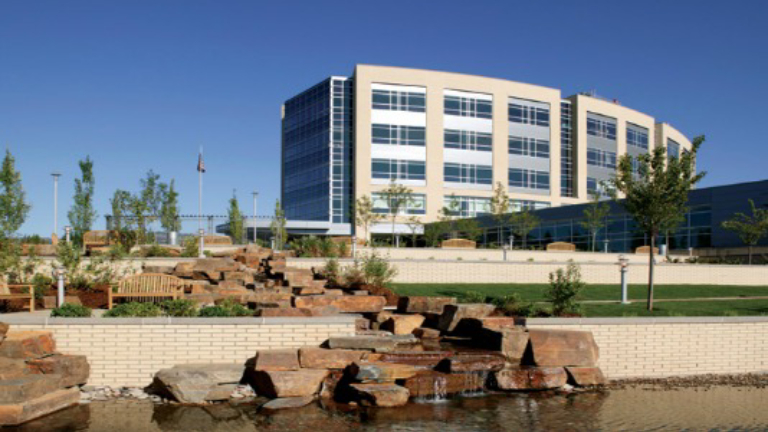Customer Story
Asante Rogue Regional Medical Center
Asante Rogue Regional Medical Center added a fifth chiller and updated controls with Trane, saving nearly $187,000 annually and increasing redundancy and energy efficiency.

Quick Facts
- Location
- Medford, Oregon
- Industry
- Healthcare
- Products
- Chillers • Controls • CenTraVac Chillers • Tracer SC+ • Trane Intelligent Services
- Topics
- Efficiency • Cost-Saving
- Services
- Energy Analysis & Monitoring

The Challenge
As Asante Rogue Regional Medical Center continued to grow, its needs were three-pronged. Concerned that the cooling capacity of its four chillers might prove to be insufficient, particularly in the event of a system failure, administrators sought to add a fifth chiller for redundancy. The hospital also wished to consolidate their aging controls, a compilation of equipment from three different suppliers with varying levels of support, into an updated controls system supported by one supplier. With improving energy efficiency always a focus, the hospital commissioned a full scale energy audit by an independent third party to identify ways to reduce energy consumption. “We experience warm weather here, and keeping a medical facility cool is critical,” said Jeff Robbins, facilities manager, Asante Rogue Regional Medical Center. “If we would have lost one of the chillers, we would have had to shed load, and normal operations would be impossible.”
The Solution
Based on a successful partnership of more than fifteen years, Asante Rogue Regional Medical Center and Trane worked together to develop an approach that would allow the hospital to achieve its three goals of increased redundancy, updated controls and energy savings, by leveraging the savings provided by each goal to enable the other two.
Increasing redundancy and efficiency
The hospital’s chilled water plant consisted of three constant speed Trane® CenTraVac™ centrifugal chillers, and one variable speed chiller. To meet the need for increased redundancy, a 500-ton, CenTraVac chiller with an Adaptive Frequency™ drive (AFD) was added to the plant. The addition provided the highest efficiency no matter what the conditions were, highly loaded or during part load conditions that are seen in the spring, fall or winter months. This meant that it would be the "go to" chiller--first on, last off--providing savings year round and enabling the medical center to gain redundancy. The hospital would also continue to enjoy the low cost of maintenance offered by the CenTraVac design that incorporates the industry's fewest moving parts and the highest uptime.
Identifying energy saving opportunities
Trane provided data to assist Energy Trust of Oregon, an independent nonprofit organization dedicated to helping utility customers benefit from saving energy, in completing a full-scale energy study to identify potential projects to help reduce the hospital’s energy consumption. “Trane did a lot of leg work and provided documentation,” said Robbins. “Energy Trust of Oregon created a short list of about nine opportunities. We took the one with the biggest payback and the least spend, adding variable frequency drives.”
Upgrading the chilled water system
In reviewing chiller run times, it was discovered that a second chiller would often turn on to meet chilled water demand, indicating the plant was suffering from “low delta-T syndrome” (LDTS). To decrease the need for second chiller start up, VFDs were added on all cooling tower fans to adjust fan speed as load changes, while maintaining the flow required and providing better control of the condenser water, improving overall plant efficiency. VFDs on the water pumps work in conjunction with the water reset and the cooling tower fan VFDs to better control the condenser water. Condenser water temperature was lowered to decrease compressor lift, improving chiller efficiency and energy savings. During low load times, chilled water temperature is increased, which allows for more efficient chiller operation.
Optimizing operations, managing energy use
The multi-vendor controls system was retrofit with a Trane® Tracer™ SC, allowing the hospital to streamline facility management with a flexible, cost effective solution for building automation and comfort management. With Web-enabled user interface and secure access technology, facility managers and Trane professionals can remotely login to view, troubleshoot and perform remote inspections of the system.
The Tracer SC collects data from meters installed throughout the facility to enable the use of Trane Intelligent Services Energy Performance. With ongoing support from Trane building professionals, the hospital is able to monitor energy use, uncover inefficiencies, and make informed energy management decisions. Using Energy Performance, the Trane team evaluates the effectiveness of implemented projects, identifies improvements, and provides ongoing energy management.
The Results
With Trane serving as its single-source for equipment, controls and service, Asante Rogue Valley Medical Center was able to achieve its goals of increased redundancy, updated controls and energy savings. The hospital and Trane worked through the project details with Energy Trust of Oregon, resulting in utility incentives of $304,250 dollars. The Trane Intelligent Services team validated that the actual savings exceeded the chiller plant kWh savings target by 150+ percent, reducing costs more than 9 percent over baseline, or nearly $187,000.
Efforts to sustain and further increase these results utilize the Trane Intelligent Services team for continued monitoring of energy consumption and Trane Energy Performance analytics. Automated fault detection and diagnostics (AFDDs) and Trane Building Performance are being evaluated to flag system performance issues and help drive further operational efficiencies.
“It was a great collaborative effort,” said Robbins. “We were able to leverage the energy rebate we received from the controls portion of the project to help pay for the chiller plant upgrade. Each part of the project enhanced the benefits of the other parts. In the end, one plus one plus one equaled six.”


